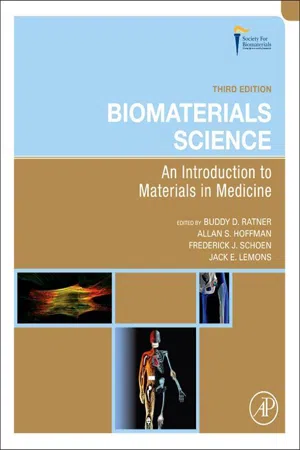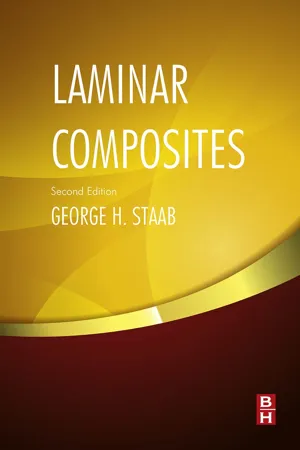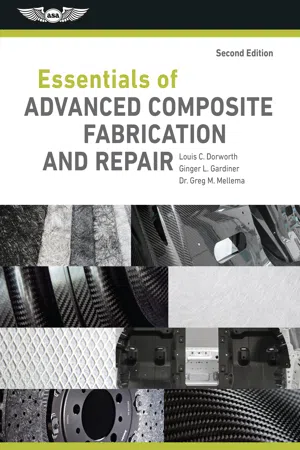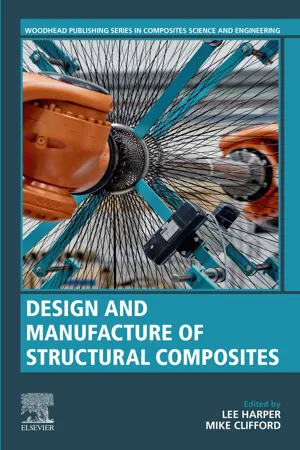Technology & Engineering
Composite Body
A composite body refers to a material made from two or more different substances with distinct properties, combined to create a new material with enhanced characteristics. These substances can include polymers, ceramics, or metals, and the resulting composite body often exhibits improved strength, durability, and other desirable properties compared to its individual components.
Written by Perlego with AI-assistance
Related key terms
Related key terms
1 of 4
Related key terms
1 of 3
7 Key excerpts on "Composite Body"
- eBook - ePub
Biomaterials Science
An Introduction to Materials in Medicine
- Buddy D. Ratner, Allan S. Hoffman, Frederick J. Schoen, Jack E. Lemons(Authors)
- 2012(Publication Date)
- Academic Press(Publisher)
Chapter I.2.9
Composites
Claudio Migliaresi Department of Materials Engineering and Industrial Technologies and BioTech Research Center, University of Trento, Trento, ItalyIntroduction
The word composite means “consisting of two or more distinct parts.” At the atomic level, materials such as metal alloys and polymeric materials could be called composite materials in that they consist of different and distinct atomic groupings. At the microstructural level (about 1 to 10 microns), a metal alloy such as a plain carbon steel containing ferrite and pearlite could be called a composite material since the ferrite and pearlite are distinctly visible constituents as observed in the optical microscope.In engineering, a composite material usually refers to a material consisting of constituents in the nano- to micro- to macrosize range, each having a distinct interface separating them. Such composites usually consist of one or more discontinuous phases embedded within a continuous phase. The discontinuous phase is usually harder and stronger than the continuous phase, and is called the reinforcement or reinforcing material , whereas the continuous phase is termed the matrix . In some cases, tough fillers, e.g., rubber particles, are combined with brittle matrices in order to produce higher toughness materials with better impact strength. In other cases, the “reinforcement” could be aimed at achieving specific functional properties, such as bioactivity in the case of biomedical composites. Many body tissues are composites, such as extracellular matrix (ECM), tendons, ligaments, skin, bone, and so on, with an additional complexity due to their hierarchical structure.The addition to a matrix of harder, stronger or tougher fillers may improve to different extents the resulting material stiffness, strength or toughness, depending on the filler type, content, and filler–matrix adhesion. Properties of composites are strongly influenced by the properties of their constituent materials, their distribution and content, and the interface and interphase interactions between them. The interface is particularly important for short fiber- or particle-reinforced composites. External applied stresses are in fact transferred from the matrix to the filler through the interface, and properties of composites with the same constituents but strong or weak interfaces can be better or worse than those of the pure matrix. - eBook - ePub
- George Staab(Author)
- 2015(Publication Date)
- Butterworth-Heinemann(Publisher)
3 ]. The B-2 bomber contains carbon and glass fibers, epoxy resin matrices, high-temperature polyimides as well as other materials in more than 10,000 composite components. It is considered to be one of the first major steps in making aircraft structures primary from composites. Composites are also used in race cars, tennis rackets, golf clubs, and other sports and leisure products. Although composite materials technology has grown rapidly, it is not fully developed. New combinations of fiber/resin systems, and even new materials are constantly being developed. The best one can hope to do is identify the types of composites that exist through broad characterizations and classifications.1.2 Characteristics of a composite material
The constituents of a composite are generally arranged so that one or more discontinuous phase is embedded in a continuous phase. The discontinuous phase is termed the reinforcement and the continuous phase is the matrix . An exception to this is rubber particles suspended in a rigid rubber matrix, which produces a class of materials known as rubber-modified polymers. In general, the reinforcements are much stronger and stiffer than the matrix. Both constituents are required, and each must accomplish specific tasks if the composite is to perform as intended.A material is generally stronger and stiffer in fiber form than in bulk form. The number of microscopic flaws which act as fracture initiation sites in bulk materials are reduced when the material is drawn into a thinner section. In fiber form, the material will typically contain very few microscopic flaws from which cracks may initiate to produce catastrophic failure. Therefore, the strength of the fiber is greater than that of the bulk material. Individual fibers are hard to control and form into useable components. Without a binder material to separate them, they can become knotted, twisted, and hard to separate. The binder (matrix) material must be continuous and surround each fiber so that they are kept distinctly separate from adjacent fibers and the entire material system is easier to handle and work with. - Louis C. Dorworth, Ginger L. Gardiner, Dr. Greg M. Mellema(Authors)
- 2019(Publication Date)
- Aviation Supplies & Academics, Inc.(Publisher)
Chapter 1: Composite Technology Overview Composites vs. Advanced CompositesComposites are comprised of two or more materials working together, where each constituent material retains its unique identity within the composite and contributes its own structural properties, yet upon combination the resulting material has superior properties to those of its constituents. A good example of an everyday composite material is concrete. Concrete is made with select amounts of sand, aggregate, and perhaps even glass fiber mixed with cement to bind it together. If the concrete were broken open, the individual constituents would be visible. The type and quantities of these individual constituents can also be adjusted to give the resulting concrete different properties depending on the application.This textbook is focused on composite laminates, which combine fibers and a matrix material that binds the fibers together. There are many different types of composite materials in use today. One example is fiber-reinforced plastic (FRP) composites made with short glass fibers in a polymer resin or plastic matrix. These materials are used in bath tubs, showers, pools, doors, car fenders, and a variety of construction materials including wall panels, corrugated sheet, profiles, and skylights. (Figure 1-1)Figure 1-1. Fiber-reinforced compositeHighly loaded composite structures typically use continuous or long-fiber reinforcement that transfers load along bundles or layers (plies- eBook - ePub
- Lee Harper, Mike Clifford(Authors)
- 2022(Publication Date)
- Woodhead Publishing(Publisher)
Section A Introduction to composite materialsPassage contains an image
1: Introduction
Lee Harper; Mike Clifford Composites Research Group, Faculty of Engineering, University of Nottingham, Nottingham, United KingdomAbstract
Fibre-reinforced polymer composites are acknowledged to offer some of the highest specific properties (stiffness, strength) of any engineering materials, but this chapter takes a look at why these materials are not more widely adopted for general structural applications. A brief introduction explains the synergy created between the fibres and the polymer, enabling the applied load to be shared by the two constituents. The chapter discusses the links amongst manufacturing process, mechanical performance, and cost, providing a brief history of technology developments, before considering new applications and future challenges faced by the sector.Keywords
Polymer; Fiber; Composite; Manufacturing; Design; Process; Automation; Sustainability1.1: What is a composite?
Fibre-reinforced composites offer significant performance advantages over other materials. Their high specific stiffness and strength enable the creation of innovative engineering structures and can lead to environmental benefits, such as fuel savings via reduced mass for transport applications. In addition, their construction enables the creation of multi-functional structures, delivering transformative design opportunities.A composite material consists of two or more constituents, typically a stiff, brittle fibre surrounded by a matrix. The arrangement and type of reinforcement dominate the mechanical properties of the composite, with the matrix material responsible for transferring stress from fibre to fibre whilst maintaining the fibre spacings and orientations. The matrix also provides vital protection to the fibres from abrasion and the environment. The combination of the two constituents results in a new material with remarkable anisotropy, sometimes with mechanical properties (e.g., tensile strength) that vary by orders of magnitude depending on the orientation and volume content of the reinforcement. Engineering composites are typically built up from individual fibre plies at different orientations, which are laminated layer by layer to create the final structure. Fig. 1.1 - eBook - ePub
Fabrication and Machining of Advanced Materials and Composites
Opportunities and Challenges
- Subhash Singh, Dinesh Kumar, Subhash Singh, Dinesh Kumar(Authors)
- 2022(Publication Date)
- CRC Press(Publisher)
Chapter 1 Introduction, History, and Origin of Composite Materials Subhash Singh Department of Mechanical and Automation Engineering, Indira Gandhi Delhi Technical University for Women, New Delhi, India Mohammad Uddin Department of Mechanical Engineering, South University of Australia Chander Prakash School of Mechanical Engineering, Lovely Professional University, Phagwara, IndiaDOI: 10.1201/9781003327370-1CONTENTS- 1.1 Introduction to Composites
- 1.2 Applications of Composites
- 1.2.1 Aircrafts and Aerospace
- 1.2.2 Automotive and Transportation
- 1.2.3 Marine
- 1.2.4 Construction and Infrastructure
- 1.2.5 Corrosive Environments
- 1.2.6 Energy
- 1.2.7 Electricals and Electronics
- 1.2.8 Sports/Recreational Applications
- 1.3 Historical Evolution of the Composites
- 1.4 Conclusions
- References
1.1 Introduction to CompositesComposites are material systems with multiple phases produced by combining diverse materials in an attempt to achieve those superior characteristics as well as performance which cannot be achieved by the individual constituting components [1 ]. Unlike in alloys, the obtained phases within a composite aren’t due to phase transformations, natural reactions, or any alternative phenomena. An alloy is always a homogeneous mixture in which the components added don’t retain their original characteristics and are generated by natural processes. This isn’t the case within a composite because the added constituents restore their original characteristics and also the composite needn’t always be homogenous [2 ]. That's the basic difference between an alloy and a composite. When observed at a macroscopic scale, among the various phases, a composite would generally comprise of a continuous, weaker phase, termed “the matrix” and a much stronger, stiffer phase termed “reinforcement.” But in certain situations, due to the effects of processing and chemical reactions, between the phases there would be another distinct phase termed “interphase” present among the matrix as well as the reinforcements [3 ]. Finally, a composite is formed with stacked layers of reinforcement fibers as well as a matrix with required characteristics in a particular direction or in multi-directions. Fig. 1.1 - eBook - ePub
Composite Materials
Properties, Characterisation, and Applications
- Amit Sachdeva, Pramod Kumar Singh, Hee Woo Rhee, Amit Sachdeva, Pramod Kumar Singh, Hee Woo Rhee(Authors)
- 2021(Publication Date)
- CRC Press(Publisher)
Composite materials, a mixture of two or more non-soluble systems, are interesting in terms of their unique characteristics compared with monolithic systems. The composite materials are classified, on the basis of their matrix, into three main categories: polymer-matrix composites, ceramic-matrix composites, and metal-matrix composites. The electrical and mechanical properties of the monolithic systems can be greatly improved upon dispersion of specific reinforcements. The overall properties of composite materials are mainly decided by the individual constituents and the synthesis/preparation technique; therefore, reinforcement and the matrix are chosen to acquire specific properties meeting the requirement of the application.References- 1 .Mangalgiri, P. D. “Composite materials for aerospace applications .” Bulletin of Materials Science22 , no. 3 (1999 ): 657 –664 .
- 2 .Kinsley-Jones, M. 2006 “Airbus’s A350 vision takes shape—Flight takes an in-depth look at the new twinjet”, Flight International 12 Dec. 2006 http://www.flightglobal.com/news/articles/airbus39s-a350-vision-takesshape-flight-takes-an-in-depth-look-at-the-new-211028/
- 3 .http://www.technologystudent.com/joints/reinforc1.html
- 4 .Anon . “Composites Penetration—Step Change Underway with Intermediate Modulus Carbon Fiber as the Standard”, Hexcel Corporationx , http://www.sec.gov/Archives/edgar/data/717605/000110465908021748/g97851bci012.jpg
- 5 .Haghshenas, M. “Metal–matrix composites .” Reference Module in Materials Science and Materials Engineering(2016 ): 03950 –03953 . DOI:10.1016/B978-0-12-803581-8.03950-3
- 6 .Business Communications Company , RGB-108N Metal−matrix composites in the 21st Century: Markets and Opportunities, 2006 . http://www.bccresearch.com/marketresearch/advanced-materials/metal-matrix-compositesmarket-avm012d.html
- 7 .Thakur, Vijay Kumar , Guoqiang Ding , Jan Ma , Pooi See Lee , and Xuehong Lu. “Hybrid materials and polymer electrolytes for electrochromic device applications .”Advanced materials24 , no. 30 (2012 ): 4071 –4096 .
- 8.Park, Chul Soon , Changsoo Lee , and Oh Seok Kwon. “Conducting polymer based nanobiosensors .”Polymers8 , no. 7 (2016 ): 249 .
- 9 .Omar, FatinSaiha , Navaneethan Duraisamy , K. Ramesh , and S. Ramesh. “Conducting polymer and its composite materials based electrochemical sensor for Nicotinamide Adenine Dinucleotide (NADH) .”Biosensors and Bioelectronics79 (2016 ): 763 –775 .
- 10 .Taherian, Reza . “Experimental and analytical model for the electrical conductivity of polymer–based nanocomposites
- eBook - ePub
- P. E. Irving, C. Soutis(Authors)
- 2019(Publication Date)
- Woodhead Publishing(Publisher)
Part One Design and manufacture of composite components for aerospace structuresOutline1. Aerospace engineering requirements in building with composites 2. Modeling of 2D and 3D woven composites 3. Manufacturing processes for composite materials and components for aerospace applications 4. Manufacturing defects in composites and their effects on performancePassage contains an image
1Aerospace engineering requirements in building with composites
Constantinos Soutis School of Mechanical, Aerospace and Civil Engineering and the Aerospace Research Institute, University of Manchester, Manchester, United kingdomAbstract
The growing use of composite material has arisen from their high specific strength and stiffness when compared to the more conventional materials, and the ability to tailor their structure to produce aerodynamically more efficient structural configurations. In this introductory chapter, it is argued that fiber-reinforced polymers, especially carbon fiber-reinforced plastics can and will, in the near future, contribute more than 50% of the structural mass of an aircraft. Of course, affordability is the key to survival in aerospace, whether civil or military and therefore, effort should be devoted to low-cost manufacturing methods in addition to analysis and computational simulation of the manufacturing and assembly process. The simulation of the structural performance should not be neglected since they are intimately connected. Virtual reality models in engineering prior to manufacturing to identify potential problems will make Industry 4.0 and the smart factory for composites a reality. Industry 4.0 focuses on data-driven manufacturing, where in the future, billions of machines, systems, and sensors will communicate with each other and share information, physical systems connected to digital twins, the Industrial Internet of Things (IIoT). This will not only enable companies to make design and production significantly more efficient, but it will also give them greater flexibility when it comes to tailoring production to meet market requirements.
Index pages curate the most relevant extracts from our library of academic textbooks. They’ve been created using an in-house natural language model (NLM), each adding context and meaning to key research topics.
Explore more topic indexes
Explore more topic indexes
1 of 6
Explore more topic indexes
1 of 4






